South Cumberland Islands is a national park in Queensland, Australia, 831 km northwest of Brisbane. It is famous for the marine stingers which can be found in the waters of the park between October and May.

Uroplatus is a genus of geckos, commonly referred to as leaf-tail geckos or flat-tailed geckos, which are endemic to Madagascar and its coastal islands, such as Nosy Be. They are nocturnal, insectivorous lizards found exclusively in primary and secondary forest.

Carphodactylus is a monotypic genus of geckos in the family Carphodactylidae. The genus consists of the sole species Carphodactylus laevis, commonly known as the chameleon gecko. The species is endemic to the rainforests of northeastern Australia. It is rated as Least Concern, as it is common within its range and occurs within protected areas. It currently experiences no major threats, though long-term climate change may alter or reduce its geographic distribution under some scenarios.

Phyllurus is a small genus of Australian leaf-tailed geckos, lizards in the family Carphodactylidae. Rarely seen outside their native habitat, they are notable for their highly effective camouflage which is in part aided by the spiny tubercles that cover every body part.
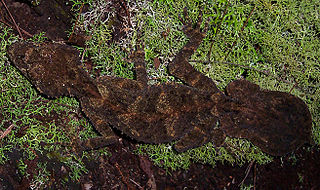
Saltuarius is a genus of larger Australian geckos, known collectively as leaf-tailed geckos. The genus was created in 1993 to accommodate some former members of the genus Phyllurus. These geckos appear very similar to the Uroplatus geckos native to Madagascar. However, this is a convergent evolution.

Brachypterois serrulata, the sawcheek scorpionfish or pygmy lionfish, is a species of scorpionfish native to the northwestern Pacific Ocean.

Cape Melville is a headland on the eastern coast of the Cape York Peninsula in Australia. To its west lies Princess Charlotte Bay. It is part of the Cape Melville National Park. Cape Melville was named Stoney Cape in 1815 by Lieutenant Charles Jeffreys on the HM Kangaroo but later renamed by him as Cape Melville

The European leaf-toed gecko is a species of lizard in the family Sphaerodactylidae. It is found in coastal regions of France, Italy and Tunisia and on Mediterranean islands. Its natural habitats are rocky areas and rocky shores.

The Kapala stingaree is a species of stingray in the family Urolophidae, endemic to inshore waters off southeastern Queensland and New South Wales. It is commonly found on and around rocky reefs at a depth of 10–130 m (33–427 ft). Reaching 51 cm (20 in) in length, the Kapala stingaree has a rounded, diamond-shaped pectoral fin disc and a slender tail, which ends in a leaf-shaped caudal fin and bears lateral skin folds and a small dorsal fin in front of the stinging spine. It has a distinctive bell-shaped curtain of skin between its nostrils. This species is greenish above, with a highly variable pattern of dark markings usually found outside and between the eyes, and over the back and tail.
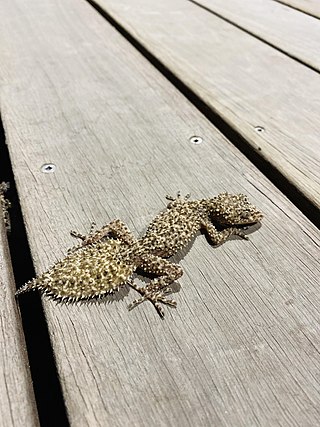
The broad-tailed gecko, southern leaf-tailed gecko, or Sydney leaf-tailed gecko is a common gecko of the family Carphodactylidae found in the Sydney Basin. The species uses its mottled colour to camouflage against bark or rock, and if threatened can drop its large fleshy tail as a decoy. The tail is also useful for fat storage. This species of gecko is available in captivity as a pet, they are a nocturnal ambush hunter, relying on camouflage and patience to catch prey. Primary prey items include large nocturnal invertebrates such as spiders, cockroaches and beetles.
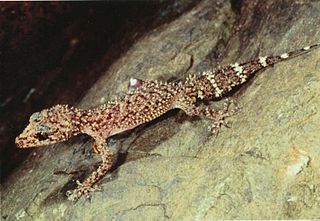
Champion's leaf-tailed gecko, also known commonly as the Koumala leaf-tailed gecko, is a species of gecko, a lizard in the family Carphodactylidae. The species is endemic to Australia.
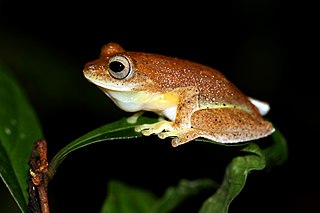
Mercurana is a genus of arboreal frogs belonging to the family Rhacophoridae. The genus was named from the only known species Mercurana myristicapalustris, which was described in 2013 from the Western Ghats of Kerala, India. The generic name was derived from and given as a tribute to Freddie Mercury, the late vocalist of the British rock band Queen, in combination with the Latin name for "frog". The frog is different from other related frogs in that it has extensively webbed toes, lives only in swampy lowlands, and lays its eggs on mud with which it carefully mixes leaf litter.
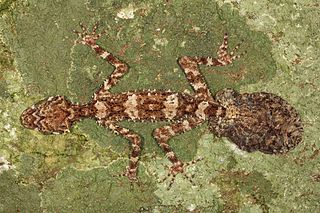
The Cape Melville leaf-tailed gecko is a species of geckos that is endemic to the Melville Range on Cape Melville in Northern Australia. The species was described in 2013 by Australian zoologists Conrad Hoskin and Patrick J. Couper. The lizards are about 20 cm (7.9 in) long and are believed to be a relic species from the time period rainforests were more abundant in Australia. The name derives from the Latin word for "extraordinary" or "exquisite", and refers to the lizard's distinctive, camouflaged appearance. It hides among rocky boulders in the day and emerges at night to hunt on rocks and trees. The lizard has large eyes, a long and slender body, and specialized limbs adapted to life in dimly lit boulder fields.
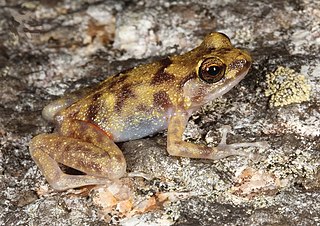
Cophixalus petrophilus, the blotched boulder-frog, is a species of frogs from the Cape York Peninsula that was described in 2013. It is one of three newly described vertebrate species from Cape Melville, Australia, the other two being skink Saproscincus saltus and gecko Saltuarius eximius. The specific name petrophilus means "rock-loving" and refers to restriction of this species to boulder field habitats.

Uroplatus sameiti is a species of leaf-tailed gecko. Like all members of the genus Uroplatus, U. sameiti is endemic to Madagascar, and is found in primary and secondary forests on the island. It has the ability to change its skin colour to match its surroundings and possesses dermal flaps which break up its outline when at rest.

The northern leaf-tailed gecko is a species of the genus Saltuarius, the Australian leaf-tailed geckos.
Phyllurus amnicola, also known as the Mount Elliot leaf-tailed gecko or the Riverine leaf-tailed gecko, is a species of gecko found in Australia. It is endemic to Mount Elliot in Bowling Green Bay National Park in northeastern Queensland.
Phyllurus caudiannulatus, also known as the Bulburin leaf-tailed gecko or ringed thin-tail gecko is a gecko found in Australia. It is endemic to the Bulburin State Forest in the Dawes Range and Many Peaks Range in southeastern Queensland.
Phyllurus gulbaru, the Gulbaru leaf-tailed gecko, is a species of gecko found in Australia. It is endemic to the extreme southern end of the Paluma Range in Queensland.

Saltuarius salebrosus, also known as the rough-throated leaf-tailed gecko or Central Queensland leaf-tailed gecko, is a gecko found in Australia. It is endemic to dry areas in mid-eastern and south-central Queensland.
















